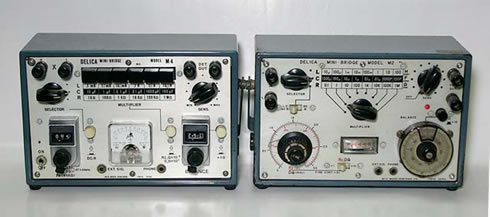| History & Topics @ |
|
Where is missing M4H
|
| In 1964, a compact, solid state, battery operated, wide range and low priced RCL bridge: Mini Bridge M1 with }1% basic accuracy was introduced on the electronics market. A lunch-box sized newcomer has won popularity among heavy and expensive predecessors and evolved to M2 for higher resolution, M3 for higher frequency up to 1 MHz, M5/M1D with digital readout, M6 for easy balancing and final / flag ship model D1S with LCD digital display. You might notice M4 is missing. This is a failed story of an M4 produced in 1970s but never sold. |
 |
| Picture above shows Mini Bridge M4 at left
and an elder prototype M2. They are similar in size and working principles
but different in appearance. Both use 10-turn helical variable resistor
for balancing arm but unlike in readout display: While M2 adopts circular
analog dials for balance and D, Q readings, M4 uses fashionable gear
drive mechanic counter with odd-meter type readout for both balance
and D, Q. Clearly, a designer has aimed modern looking symmetrical
appearance, but unfortunately, flat 8 position push-button range switch
of proper size had been unavailable those days, but 6 positions was
the maximum. Instead of using M2fs compact 8 position rotary switch,
designer tweaked changing inner standard resister and capacitor to
attain broad measuring ranges. The effort increased decimal calculations
and spoiled easy handling. The project was abandoned but the know-how
of switching inner standards was later applied on designing laboratory
type precision bridge 1300 and 12K. The rotary range switch has been
used, without hesitation, for all later models. The loss was partly
compensated. 40 year old M4 is here still intact, occasionally used for its original purposes like space probe Voyagers. Sorry, we have no catalogs or circuit diagrams about M4 to satisfy your interest. |
| History & Topics - INDEX |
| DELICA @MITA MUSEN KENKYUSHO LTD |